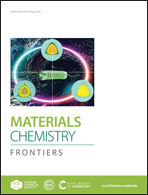A self-assembly based on a hydrogel interface: facile, rapid, and large-scale preparation of colloidal photonic crystals†
Abstract
As photonic crystals (PCs) are one of the most widely studied artificial biomimetic periodic nanostructures, their preparation methods have attracted significant attention. Recently, several methods have been developed for the self-assembly of PCs at solid and air/water interfaces. However, to date, their self-assembly at a hydrogel interface (HI) with special properties has not been explored and that at an air/gel interface is also rarely reported. Herein, a simple and novel strategy for the rapid self-assembly of PCs using a HI as an assembly interface is demonstrated. This approach is completely different from the preparation strategy of polymerized crystalline colloidal arrays (PCCAs), which involves the entrapment of a colloidal array inside a gel. Unlike the self-assembly at solid or air/water interfaces, the proposed method is faster and simpler and has the ability to prepare three-dimensional (3D) PCs on flat or curved surfaces. The reflection intensity of the hydrogel interface-photonic crystals (HI-PCs) could exceed 80%. Particularly, the transmissivity at a specific wavelength reached as low as 0.1%. Therefore, with the recent progress in the self-assembly of interfaces, soft matter interfaces, such as a hydrogel interface, will play an important new role, which is expected to open up an interesting field of research and provide more ideas for the preparation of advanced materials.



 Please wait while we load your content...
Please wait while we load your content...